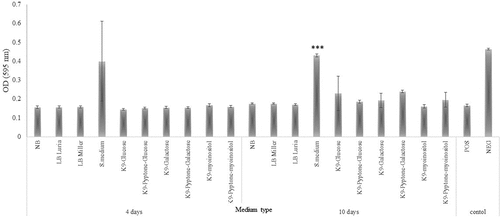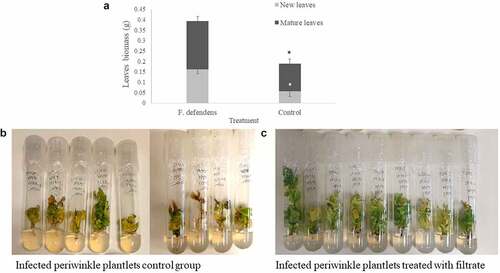Figures & data
Table 1. The effects of different growth media on F. defendens total cell counts (OD595nm) and live cell counts (CFU/ml)
Figure 1. F. defendens bacterial growth curves in different media as was measured by total count using spectrophotometer. A. Defined media based on K9 minimal salt medium, supplemented with a carbon source (glucose, galactose, or myoinositol), with or without peptone. B. Rich non-defined media: S-medium, NB, LB (LB Miller and LB Luria). The results were calculated from five replicates samples assessed for each medium formulation in three repeated experiments.

Figure 2. The inhibitory effect of different F. defendens filtrates on S. melliferum growth in culture at two time points. Filtrates were tested after 4 and 10 days of F. defendens growth prior to filtration. Higher OD values correspond to lower growth. Sterile medium served as a negative control (NEG), and S. melliferum (approx. 1x107CFU/ml) was cultured in S-medium as a positive control (POS). Data are given as means with standard deviations from triplicate samples, with results being representative of one out of three biological experiments. ***P < .01.

Figure 3. The effects of F. defendens filtrate treatment on the growth of phytoplasma-infected periwinkle plantlets at 21 days post-treatment. A. Plant biomass of mature and new leaves. B. Control: infected periwinkle plantlets treated with 1 mL of filtrate prepared from sterile S-medium. C. infected periwinkle plantlets treated with 1 mL of filtrate prepared from a 10 day F. defendens cell suspension. Each plantlet was dipped in filtrate for 24 h before being replanted in plant medium. Data are given as means with standard deviations from nine replicant samples. *P < .05.

